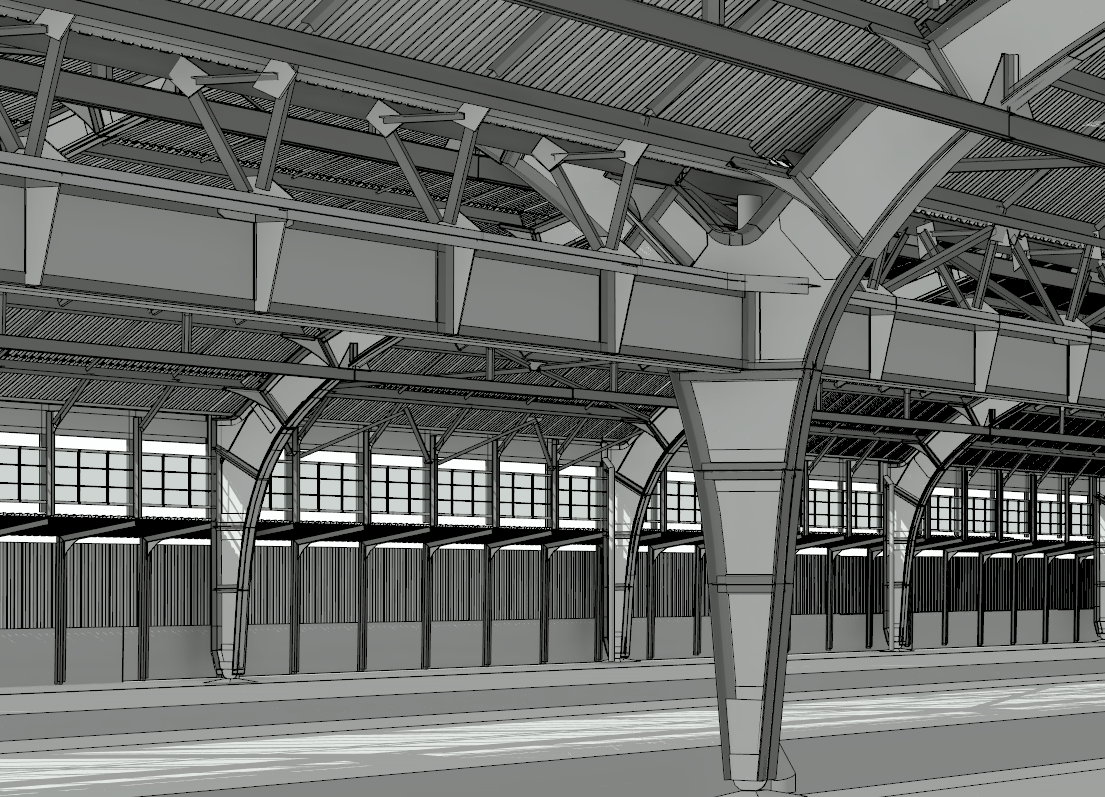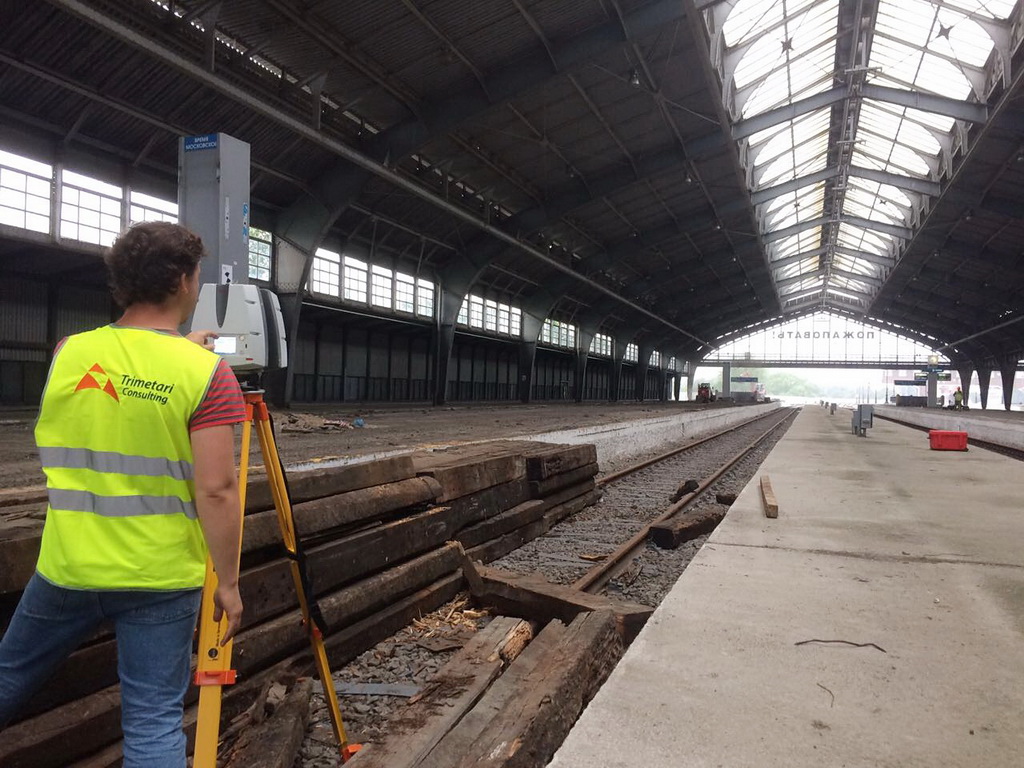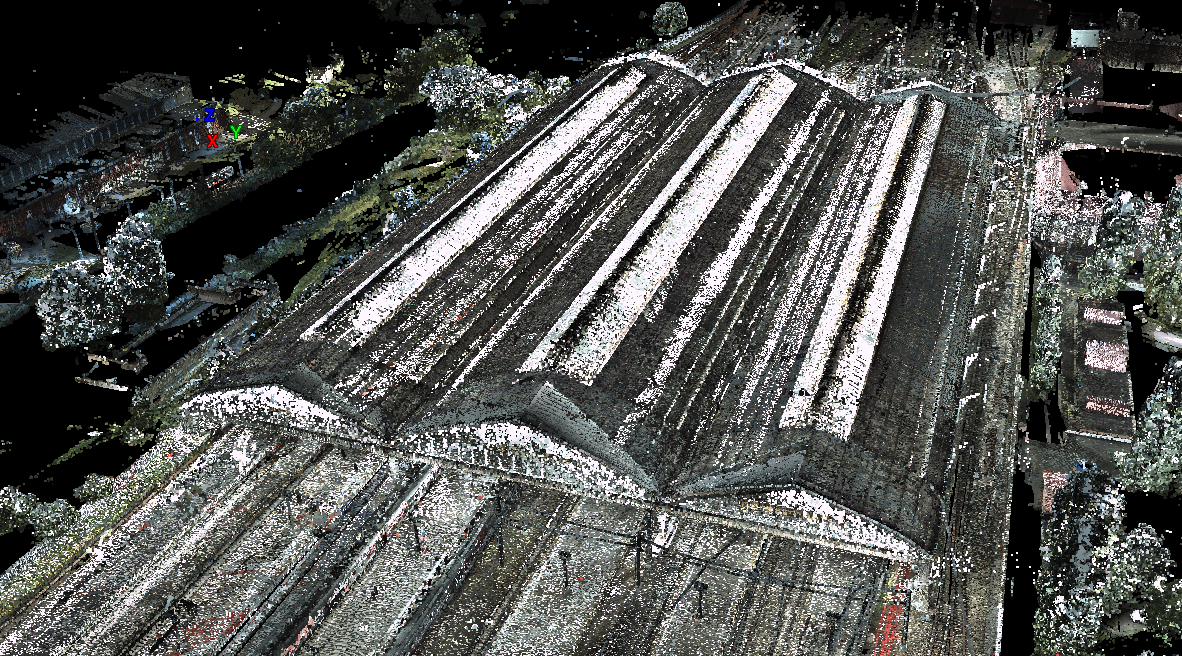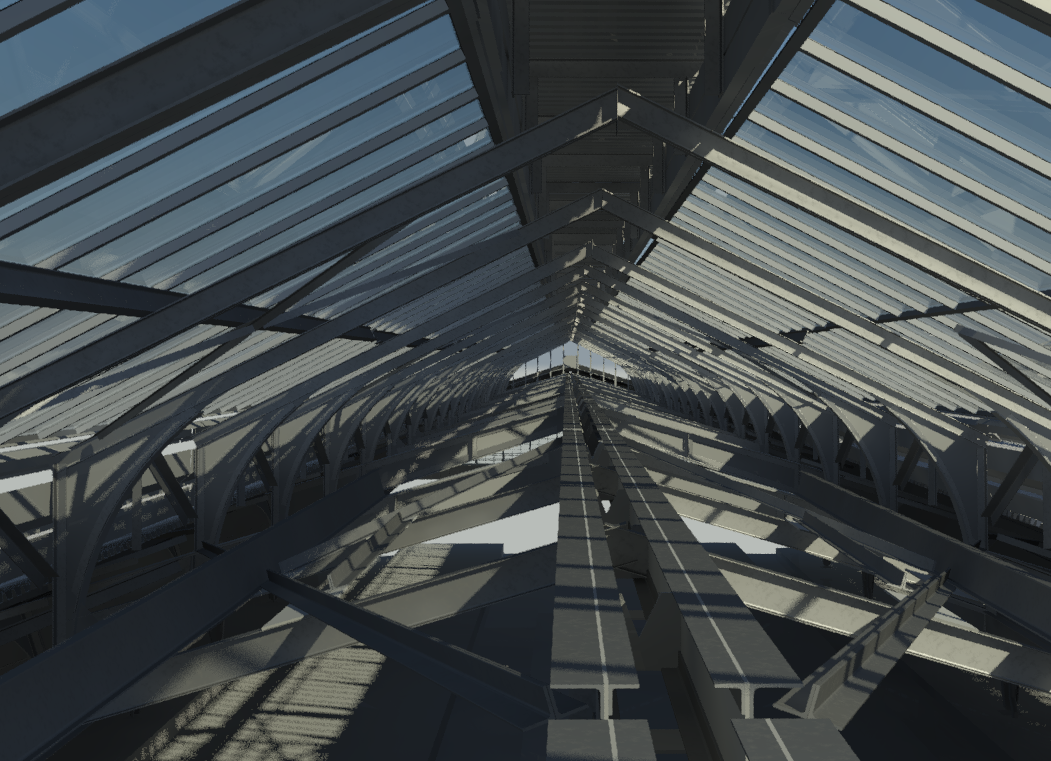 In November 2017, experts of the company Trimetari Consulting LLC completed the work on terrestrial laser scanning and BIM-modeling of the train shed of the Yuzhny Railway Station in Kaliningrad. The work was done with a Leica ScanStation P40 laser scanner in real-color mode. 125 stations (scanner standing points) were executed, the total cloud contains about 16 billion points. As a result of combining the scanner data in a single point cloud, an error of 0.002 m data acquisition was achieved. Based on the results of laser scanning, a BIM model was created in the Autodesk Revit software.
In November 2017, experts of the company Trimetari Consulting LLC completed the work on terrestrial laser scanning and BIM-modeling of the train shed of the Yuzhny Railway Station in Kaliningrad. The work was done with a Leica ScanStation P40 laser scanner in real-color mode. 125 stations (scanner standing points) were executed, the total cloud contains about 16 billion points. As a result of combining the scanner data in a single point cloud, an error of 0.002 m data acquisition was achieved. Based on the results of laser scanning, a BIM model was created in the Autodesk Revit software.
 The train shed of the Yuzhnyi Railway Station is a steel frame structure with dimensions of 176 x 118 m, height 15.5 m, consisting of 3 arches with supports hingedly connected to reinforced concrete foundations. Spans of arches are 37 m, 43 m and 43 m. Manufacturing and installation of metal structures is made mainly with the use of connections on rivets and partly on bolts. According to the customer, the original project documentation is not available, no technical surveys have been carried out during the operation. In 1976, the beam structure was changed due to electrification of the Baltic railway junction, the as-built documentation is also missing. According to the results of the technical survey, it was decided to conduct a detailed survey of the entire design of the train shed using the laser scanning method.
The train shed of the Yuzhnyi Railway Station is a steel frame structure with dimensions of 176 x 118 m, height 15.5 m, consisting of 3 arches with supports hingedly connected to reinforced concrete foundations. Spans of arches are 37 m, 43 m and 43 m. Manufacturing and installation of metal structures is made mainly with the use of connections on rivets and partly on bolts. According to the customer, the original project documentation is not available, no technical surveys have been carried out during the operation. In 1976, the beam structure was changed due to electrification of the Baltic railway junction, the as-built documentation is also missing. According to the results of the technical survey, it was decided to conduct a detailed survey of the entire design of the train shed using the laser scanning method.
 The idea of building the Main Railway Station of Koenigsberg appeared as far back as 1896, but a concrete plan was ready only in 1914. However, its implementation was prevented by the First World War that began that year. As a result, the construction of Königsberg Hbf began only at the end of 1919, but because of inflation and the crisis in post-war Germany, construction again stalled and stretched for long ten years. The opening of the station took place only on September 19, 1929. During the battles for the city in the years of the Second World War, the station and the station were badly damaged, so for some time after the war the station did not function. It’s second birth was in 1949.
The idea of building the Main Railway Station of Koenigsberg appeared as far back as 1896, but a concrete plan was ready only in 1914. However, its implementation was prevented by the First World War that began that year. As a result, the construction of Königsberg Hbf began only at the end of 1919, but because of inflation and the crisis in post-war Germany, construction again stalled and stretched for long ten years. The opening of the station took place only on September 19, 1929. During the battles for the city in the years of the Second World War, the station and the station were badly damaged, so for some time after the war the station did not function. It’s second birth was in 1949.
The BIM (Building Information Modeling) technology in designe is based on the use of a three-dimensional information model of a building, while the 3D model of a building is not just a set of geometric elements and textures. In practice, such a model consists of strictly defined elements, virtual copies of real objects that have specific physical properties. Laser scanning using BIM-modeling not only allows you to get up-to-date information about the state of the whole object, but also reduce the costs of data conversion and processing. The primary result of laser scanning – a point cloud – can be imported and used directly in Autodesk Revit.
 The 3D model, based on laser scanning data, includes basic and auxiliary structural elements: supporting columns, arches, lantern beams, beams and cover runs, vertical and horizontal links, roofing, stained glass systems – the model contains more than 27,000 elements. The component models were executed using standard Revit tools. The process of modeling with use of point clouds in Autodesk Revit software looks like fitting of a 3D object from Revit libraries (families) into the point cloud. This allows you to take into account the actual position of the constructions and eliminates the errors that can arise when building a 3D-model from drawings or flat measurements.
The 3D model, based on laser scanning data, includes basic and auxiliary structural elements: supporting columns, arches, lantern beams, beams and cover runs, vertical and horizontal links, roofing, stained glass systems – the model contains more than 27,000 elements. The component models were executed using standard Revit tools. The process of modeling with use of point clouds in Autodesk Revit software looks like fitting of a 3D object from Revit libraries (families) into the point cloud. This allows you to take into account the actual position of the constructions and eliminates the errors that can arise when building a 3D-model from drawings or flat measurements.
As a result of the work carried out, the customer was given:
- a cloud of points in RCP format with a real RGB color (RCP project file Autodesk Recap is designed specifically for working with a point cloud and, along with an RCS file, can be inserted into an AutoCAD drawing or Autodesk Revit 3D model)
- Leica Truview spherical panoramas with the ability to measure and annotate,
- information 3D-model in the format of Autodesk RVT.
The presence of a 3D model based on laser scanning data made it possible to reveal the unreliability of the initial data in the topographical plan, and unknown before that time the deformations in the construction of the landing stage. The model was used to design the reconstruction of steel structures of the train shed, engineering calculations, calculation of the amount of material necessary for work. Laser scanning showed an incredible speed of obtaining the original data with a high degree of detail.
The company Trimetari Consulting LLC performs work on laser scanning and BIM-modeling in Russia, Europe and Middle East countries. The company’s portfolio includes a number of projects in the field of AEC, including unique and high-rise buildings and structures.
